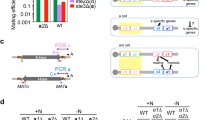Summary
The histidine (hisB) locus of Aspergillus nidulans is unusual in two ways. Firstly, it is bifunctional; besides coding for imidazole glycerol phosphate (IGP) dehydrase, it is required for the production of ascospores (fertility). It appears, therefore, to be partly homologous to the hisB locus of Salmonella typhimurium, which codes for IGP dehydrase and histidinol phosphate phosphatase. Secondly, during meiosis it is often inaccurately transmitted to the progeny (infidelity). This phenomenon may be akin to the aberrant recombination events which cause Bar reversion in Drosophila, “selfing” in Salmonella and Neurospora, and gene fusions of the haemoglobin lepore type. A molecular model is proposed to account for the results.
Similar content being viewed by others
References
Ahmed A (1964) Regulation and gene enzyme relationships in the biosynthesis of L-histidine in Neurospora, Ph.D. thesis, Yale University, New Haven, Conn
Ames BN, Garry B, Herzenberg LA (1960) The genetic control of the enzymes of histidine biosynthesis in Salmonella typhimurium. J Gen Microbiol 22:369–378
Ames BN, Hartman PE (1963) The histidine operon. Cold Spring Harbor Symp Quant Biol 28:349–356
Ames BN, Martin RB (1964) Biochemical aspects of genetics: the operon. Annu Rev Biochem 33:235–258
Baglioni C (1962) The fusion of two peptide chains in hemoglobin Lepore and its interpretation as a genetic deletion. Proc Natl Acad Sci USA 48:1880–1886
Baglioni C (1963) The chemical structure of hemoglobin Lepore and its interpretation as the result of non-homologous crossingover Proc. xI Intern Congr Genetics, The Hague
Bausum HT, Wagner RP (1965) “Selfing” and other forms of aberrant recombination in isoleucine-valine mutants of Neurospora. Genetics 51:815–830
Berlyn MB (1967) Gen-enzyme relationships in histidine biosynthesis in Aspergillus nidulans Genetics 57:561–570
Brady DR, Houston LL (1973) Some properties of the catalytic sites of imidazoleglycerolphosphate dehydratase-histidinol phosphate phasphatase, a bifunctional enzyme form Salmonella typhimurium. J Biol Chem 248:2588–2592
Brenner M, Ames BN (1971) The histidine operon and its regulation. In: Vogel HJ (ed) Metab pathways, vol 5. Academic Press, New York, pp 349–387
Chapman LF, Nester EW (1969) Gene enzyme relationships in histidine biosynthesis in Bacillus subtilis J Bacteriol 97:1444–1448
Demerec M (1962) “Selfers”-attributed to unequal crossovers in Salmonella. Proc Natl Acad Sci USA 48:1696–1704
Demerec M (1963) Selfer mutants of Salmonella typhimurium. Genetics 48:1519–1531
de Serres FJ (1969) Comparison of the complementation and genetic maps of closely linked nonallelic markers on linkage group I of Neurospra crassa. Mutat Res 8:43–50
Dressler D, Potter H (1982) Molecular mechanisms in genetic recombination. Annu Rev Biochem 51:727–761
Fink GP (1964) Gene-enzyme relations in histidine biosynthesis in yeast. Science 146:525–527
Fogel S, Mortimer RK (1970) Fidelity of meiotic gene conversion in yeast. Mol Gen Genet 109:177–185
Fritsch EF, Laan RM, Maniatis T (1980) Molecular cloning and characterization of the human β-like globin gene cluster. Cell 19:959–972
Garrick-Silversmith L, Hartman PE (1970) Histidine requiring mutants of Escherichia coli K12. Genetics 66:231–244
Holliday R (1964) A mechanism for gene conversion in fungi. Genet Res 5:282–304
Holliday R (1974) Molecular aspects of genetic exchange and gene conversion. Genetics 78:273–287
Houston LL (1973a) Specialized subregions of the bifunctional hisB gene of Salmonella typhimurium. J Bacteriol 113:82–87
Houston LL (1973b) Evidence for proteolytic degredation of histidinol phosphate phosphatase specified by nonsense mutants of the hisB gene of Salmonella typhimurium. J Bacteriol 116:88–97
Jeffreys AJ, Harris S (1982) Process of gene duplication. Nature 296:9–10
Jelinck WR, Schmid CW (1982) Repetitive sequences in eukaryotic DNA and their expression, Ann Rev Biochem 51:813–844
Käfer E (1958) An 8 chromosome map of Aspergillus nidulans. Adv Genet 9:105–145
Kloos WE, Pattee PA (1965a) A biochemical characterization of histidine dependent mutants of Staphylococcus aureus. J Gen Microbiol 39:185–194
Kloos WE, Pattee PA (1965b) Transduction analysis of the histidine region in Staphylococcus aureus. J Gen Microbiol 39:195–207
Loper JC (1961) Enzyme complementation in mixed extracts of mutants from the Salmonella histidine B locus. Proc Natl Acad Sci USA 47:1440–1450
Loper JC, Grabnar M, Stahl RC, Hartman Z, Hartman PE (1964) Genes and proteins involved in histidine biosynthesis in Salmonella. Brookhaven Symp Biol 17:15–52
Meselson M, Radding CM (1975) A general model for genetic recombination. Proc Natl Acad Sci USA 72:358–361
Millington-Ward AM, Reuser JAM, Scheele JY (1970) Localization of the hisB locus of Aspergillus nidulans. Aspergillus Newsletter 11:9–11
Ohno S (1970) Evolution by gene duplication. Springer-Verlag, Berlin-Heidelberg-New York
Pontecorvo G, Roper JA, Hemmons LM, MacDonald KD, Bufton AWJ (1953) The genetics of Aspergillus nidulans. Adv Genet 5:141–238
Pritchard RH (1955) The linear arrangement of a series of alleles of Aspergillus nidulans. Heredity 2:343–371
Russi S, Carere A, Fratello B, Khoudokormoff V (1966) Caratterazione biochimica dé alcuni mutani dé Streptomyces coelicolor rechidenti istidina. Ann Isr Super Sanitá 2:506–522
Slighton JA, Blechl AE, Smithies O (1980) Human fetal Gγ- and Aγ-globin genes: complete nucleotide sequences suggest that DNA can be exchanged between these duplicated genes. Cell 21:627–638
Smithies O (1964) Chromosomal rearrangements and protein structure. Cold Spring Harbor Symp Quant Biol 29:309–319
Streisinger G, Okada Y, Emrich J, Newton J, Tsugita A, Terzghi E, Inouye M (1966) Frameshift mutations and the genetic code. Cold Spring Harbor Symp Quant Biol 31:77–84
Sturevant AH (1925) The effects of unequal crossing-over at the Bar locus in Drosophila. Genetics 10:117–147
Author information
Authors and Affiliations
Additional information
Communicated by W. Gajewski
Rights and permissions
About this article
Cite this article
Ward, A.M.M., Reuser, J.A.M., Scheele, J.Y. et al. Bifunctionality and polarized infidelity at the hisB locus of Aspergillus nidulans . Molec Gen Genet 193, 332–339 (1984). https://doi.org/10.1007/BF00330690
Received:
Issue Date:
DOI: https://doi.org/10.1007/BF00330690




